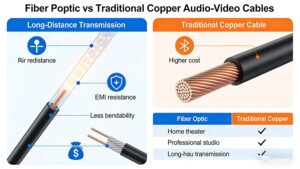Ethernet Cables
Introduction
Ethernet technology has been the backbone of wired networking for decades, providing a reliable and efficient means of data communication. Ethernet cables, which connect devices within a local area network (LAN), play a crucial role in enabling high-speed data transfer and stable connectivity. This paper explores the functionality and applications of Ethernet cables, highlighting their importance in modern networking and their impact on various sectors.
Technical Specifications
Overview of Ethernet Standards
Ethernet standards have evolved significantly since their inception, with each new version introducing enhancements in speed, bandwidth, and features. The most commonly used standards include Fast Ethernet (100 Mbps), Gigabit Ethernet (1 Gbps), and 10 Gigabit Ethernet (10 Gbps). Recent advancements have introduced 25 Gigabit, 40 Gigabit, and 100 Gigabit Ethernet, catering to the growing demand for higher data transfer rates.
Signal Transmission Mechanisms
Ethernet cables transmit data using electrical signals. The technology employs a method known as baseband signaling, where the entire bandwidth of the cable is used to transmit a single data signal. This ensures efficient and reliable data transmission over relatively long distances.
Cable Construction and Materials
High-quality Ethernet cables are constructed using materials that minimize signal degradation and electromagnetic interference. Shielding, twisted pairs of copper wires, and high-purity copper conductors are common features that enhance performance and durability. The cable length also plays a critical role in maintaining signal integrity, with longer cables requiring more robust construction to prevent signal loss.
How Ethernet Cables Work
Data Transmission Process
Ethernet cables transmit data by sending electrical signals between devices. The data is divided into packets, which are then transmitted sequentially over the cable. Each packet contains a header with information about the source and destination, as well as error-checking data to ensure accurate transmission.
Role of Twisted Pairs and Shielding
Ethernet cables typically use twisted pairs of copper wires to reduce electromagnetic interference and crosstalk between adjacent pairs. The twisting of the wires helps to cancel out any interference, ensuring a more reliable signal. Shielded Ethernet cables provide additional protection against electromagnetic interference, making them suitable for environments with high levels of electrical noise.
Categories of Ethernet Cables
Ethernet cables are categorized based on their performance characteristics, such as data transfer rate and maximum cable length. Common categories include Cat5e (1000 Mbps, 100 meters), Cat6 (10 Gbps, 55 meters), and Cat6a (10 Gbps, 100 meters). Higher categories, such as Cat7 and Cat8, offer even greater performance, with data transfer rates of up to 40 Gbps and 100 Gbps, respectively.
Advantages of Ethernet Cables
High-Speed Data Transfer
One of the key advantages of Ethernet cables is their ability to support high-speed data transfer. This ensures that users can enjoy fast and efficient communication between devices, whether they are transferring large files, streaming high-definition video, or conducting video conferences.
Reliability and Stability
Ethernet cables provide a reliable and stable connection, with minimal latency and packet loss. This makes them ideal for applications that require consistent and uninterrupted data transfer, such as online gaming, video streaming, and VoIP calls.
Compatibility and Scalability
Ethernet cables are designed to be compatible with a wide range of devices and standards. This ensures that users can easily connect different devices within a network without worrying about compatibility issues. The scalability of Ethernet technology also allows for easy expansion of networks, making it suitable for both small home networks and large enterprise environments.
Applications in Different Sectors
Home and Office Networking
In home and office environments, Ethernet cables are used to connect computers, printers, routers, and other network devices. This enables high-speed internet access, file sharing, and communication between devices, ensuring a seamless and efficient networking experience.
Data Centers and Enterprise Environments
In data centers and enterprise environments, Ethernet cables play a crucial role in connecting servers, storage devices, and networking equipment. The high-speed data transfer and reliability of Ethernet cables ensure that data centers can handle large volumes of data and provide uninterrupted service to users.
Industrial and Outdoor Applications
Ethernet cables are also used in industrial and outdoor applications, such as surveillance systems, remote monitoring, and control systems. The durability and robustness of Ethernet cables make them suitable for harsh environments, where they can withstand extreme temperatures, moisture, and mechanical stress.
Challenges and Solutions
Technical Challenges in Deployment
Deploying Ethernet cables in certain environments can present technical challenges, such as maintaining signal integrity over long distances, handling electromagnetic interference, and ensuring compatibility with existing infrastructure. Advanced signal processing technologies and adaptive equalizers are essential in overcoming these challenges and providing a reliable connection.
Innovations in Cable Technology
Innovations in cable technology, such as the use of higher-quality materials, improved shielding, and advanced signal processing chips, have significantly enhanced the performance of Ethernet cables. These advancements ensure that users can enjoy high-speed data transfer and reliable connectivity with minimal latency and interference.
Case Studies and Real-World Examples
Several case studies highlight the successful implementation of Ethernet cables in various settings. For example, in a corporate environment, Ethernet cables have enabled seamless communication and data transfer between employees, improving productivity and collaboration. In industrial settings, Ethernet cables have provided reliable connections for remote monitoring and control systems, ensuring efficient operation and safety.
Future Trends and Developments
Advancements in Ethernet Technology
The future of Ethernet technology is likely to see further advancements in bandwidth capabilities, signal processing, and material science. Innovations such as fiber optic cables and wireless solutions may also play a role in enhancing the performance and versatility of Ethernet connections.
Emerging Applications and Innovations
Emerging applications and innovations in Ethernet technology include support for higher data transfer rates, such as 400 Gigabit and 800 Gigabit Ethernet, as well as features like Power over Ethernet (PoE) and Time-Sensitive Networking (TSN). These advancements will ensure that Ethernet cables remain a vital component in the world of digital connectivity.
Conclusion
Ethernet cables play a crucial role in modern networking, offering high-speed data transfer, reliability, and compatibility with a wide range of devices. The various uses and applications of Ethernet cables in home and office networking, data centers, and industrial settings highlight their importance in today’s digital world. As technology continues to evolve, further advancements in Ethernet standards and innovations will ensure that Ethernet cables remain an essential component in the future of digital connectivity.







